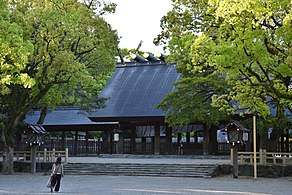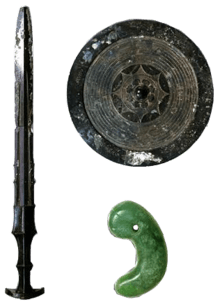Kusanagi no Tsurugi
Kusanagi-no-Tsurugi (草薙の剣) is a legendary Japanese sword and one of three Imperial Regalia of Japan. It was originally called Ame-no-Murakumo-no-Tsurugi (天叢雲剣, "Heavenly Sword of Gathering Clouds"), but its name was later changed to the more popular Kusanagi-no-Tsurugi ("Grass-Cutting Sword"). In folklore, the sword represents the virtue of valor.
| Part of the series on |
| Japanese mythology |
|---|
 |
|
| Texts and myths |
| Sacred objects |
| Mythical locations |
Legends
The history of the Kusanagi-no-Tsurugi extends into legend. According to Kojiki, the god Susanoo encountered a grieving family of kunitsukami ("gods of the land") headed by Ashinazuchi (足名椎) in Izumo Province. When Susanoo inquired of Ashinazuchi, he told him that his family was being terrorized by the fearsome Yamata no Orochi, an eight-headed serpent of Koshi, who had consumed seven of the family's eight daughters and that the creature was coming for his final daughter, Kushinada-hime (奇稲田姫). Susanoo investigated the creature, and after an abortive encounter he returned with a plan to defeat it. In return, he asked for Kushinada-hime's hand in marriage, which was agreed. Transforming her temporarily into a comb (one interpreter reads this section as "using a comb he turns into [masquerades as] Kushinada-hime") to have her company during battle, he detailed his plan into steps.
He instructed that eight vats of sake (rice wine) be prepared and put on individual platforms positioned behind a fence with eight gates. The monster took the bait and put one of its heads through each gate. With this distraction, Susanoo attacked and slew the beast (with his sword Worochi no Ara-masa[1]), chopping off each head and then proceeded to do the same to the tails. In the fourth tail, he discovered a great sword inside the body of the serpent which he called Ame-no-Murakumo-no-Tsurugi. He presented the sword to the goddess Amaterasu to settle an old grievance.

Generations later, during the reign of the twelfth Emperor, Keikō, Ame-no-Murakumo-no-Tsurugi was given to the great warrior, Yamato Takeru as part of a pair of gifts given by his aunt, Yamatohime-no-mikoto, the Shrine Maiden of Ise Shrine, to protect her nephew in times of peril.
These gifts came in handy when Yamato Takeru was lured onto an open grassland during a hunting expedition by a treacherous warlord. The lord had fiery arrows loosed to ignite the grass and trap Yamato Takeru in the field so that he would burn to death. He also killed the warrior's horse to prevent his escape. Desperately, Yamato Takeru used the Ame-no-Murakumo-no-Tsurugi to cut back the grass and remove fuel from the fire, but in doing so, he discovered that the sword enabled him to control the wind and cause it to move in the direction of his swing. Taking advantage of this magic, Yamato Takeru used his other gift, fire strikers, to enlarge the fire in the direction of the lord and his men, and he used the winds controlled by the sword to sweep the blaze toward them. In triumph, Yamato Takeru renamed the sword Kusanagi-no-Tsurugi ("Grasscutter Sword") to commemorate his narrow escape and victory. Eventually, Yamato Takeru married and later fell in battle against a monster, after ignoring his wife's advice to take the sword with him.
Folklore
Although the sword is mentioned in the Kojiki, this book is a collection of Japanese myths and is not considered a historical document. The first reliable historical mention of the sword is in the Nihonshoki.[2] Although the Nihonshoki also contains mythological stories that are not considered reliable history, it records some events that were contemporary or nearly contemporary to its writing, and these sections of the book are considered historical. In the Nihonshoki, the Kusanagi was removed from the Imperial palace in 688, and moved to Atsuta Shrine after the sword was blamed for causing Emperor Tenmu to fall ill. Along with the jewel (Yasakani no Magatama) and the mirror (Yata no Kagami), it is one of the three Imperial Regalia of Japan, the sword representing the virtue of valor.

Kusanagi is allegedly kept at Atsuta Shrine but is not available for public display. During the Edo period, while performing various repairs and upkeep at Atsuta Shrine, including replacement of the outer wooden box housing the sword, the Shinto priest Matsuoka Masanao claimed to have been one of several priests to have seen the sword. Per his account, "a stone box was inside a wooden box of length 150 cm, with red clay stuffed into the gap between them. Inside the stone box was a hollowed log of a camphor tree, acting as another box, with an interior lined with gold. Above that was placed a sword. Red clay was also stuffed between the stone box and the camphor tree box. The sword was about 82 cm long. Its blade resembled a calamus leaf. The middle of the sword had a thickness from the grip about 18cm with an appearance like a fish spine. The sword was fashioned in a white metallic color, and well maintained." After witnessing the sword, the grand priest was banished and the other priests, except for Matsuoka, died from strange diseases. The above account therefore comes from the only survivor, Matsuoka.[3]
In The Tale of the Heike, a collection of oral stories transcribed in 1371, the sword is lost at sea after the defeat of the Heike in the Battle of Dan-no-ura, a naval battle that ended in the defeat of the Heike clan forces and the child Emperor Antoku at the hands of Minamoto no Yoshitsune. In the tale, upon hearing of the Navy's defeat, the Emperor's grandmother, Taira no Tokiko, led the Emperor and his entourage to commit suicide by drowning in the waters of the strait, taking with her two of the three Imperial Regalia: the sacred jewel and the sword Kusanagi.[4] The sacred mirror was recovered in extremis when one of the ladies-in-waiting was about to jump with it into the sea.[5] Although the sacred jewel is said to have been found in its casket floating on the waves, Kusanagi was lost forever. Although written about historical events, The Tale of the Heike is a collection of epic poetry passed down orally and written down nearly 200 years after the actual events, so its reliability as an historical document is questionable.
Another story[5] holds that the sword was reportedly stolen again in the sixth century by a monk from Silla. However, his ship allegedly sank at sea, allowing the sword to wash ashore at Ise, where it was recovered by Shinto priests.
Current status
Due to the Shinto priests' refusal to show the sword, and the rather unreliable nature of its historical references, the current state of – or even the existence of - the sword as a historical artifact cannot be confirmed. The most recent appearance of the sword was in 2019 when Emperor Akihito abdicated from the throne; the sword (as well as the jewel Yasakani no Magatama, the Emperor's privy seal and the State Seal) were shrouded in packages.
See also
References
- Nihongi: Chronicles of Japan from the Earliest Times to A.D. 697. Translated by Aston, William George. Tuttle Publishing. 2005. Book I, part 1, page 56. ISBN 9780804836746.
- Nihongi: Chronicles of Japan from the Earliest Times to A.D. 697. Translated by Aston, William George. Tuttle Publishing. 2005. Book I, part 1, page 53. ISBN 9780804836746.
- First appears in Endorsement of Gyokusensyu (玉籤集裏書, Gyokusenshū uragaki) from around 1725, written by Tamaki Masahide, a Shinto priest of Umenomiya Shrine. This text is then mentioned in the Investigation of Imperial Regalia (神器考證, Jingi Kōshō), published 1898, written by Kurita Hiroshi. Kokugakuin. http://kindai.ndl.go.jp/info:ndljp/pid/815487
- The Tales of the Heike. Translated by Watson, Burton. Columbia University Press. 2006. p. 142. ISBN 9780231138024.
- The Tale of the Heike. Translated by McCullough, Helen Craig. Stanford University Press. 1988. ISBN 9780804714181.
- Naumann, Nelly. "The kusanagi sword" (PDF). In Nenrin-Jahresringe: Festgabe für Hans A. Dettmer. Ed. Klaus Müller. Wiesbaden: Harrassowitz, 1992. [158]–170.
